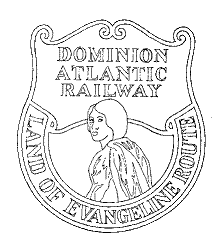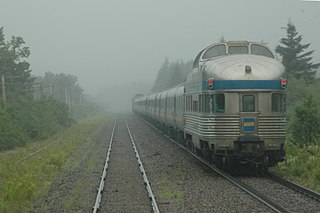
The Canadian Pacific Railway (CPR), known as CP Rail between 1968 and 1996 and simply Canadian Pacific, is a historic Canadian Class I railway incorporated in 1881. The railway is owned by Canadian Pacific Railway Limited, which began operations as legal owner in a corporate restructuring in 2001.

The Budd Rail Diesel Car, RDC or Buddliner is a self-propelled diesel multiple unit (DMU) railcar. Between 1949 and 1962, 398 RDCs were built by the Budd Company of Philadelphia, Pennsylvania, United States. The cars were primarily adopted for passenger service in rural areas with low traffic density or in short-haul commuter service, and were less expensive to operate in this context than a traditional diesel locomotive-drawn train with coaches. The cars could be used singly or coupled together in train sets and controlled from the cab of the front unit. The RDC was one of the few DMU trains to achieve commercial success in North America. RDC trains were an early example of self-contained diesel multiple unit trains, an arrangement now in common use by railways all over the world.

The Dominion Atlantic Railway was a historic railway which operated in the western part of Nova Scotia in Canada, primarily through an agricultural district known as the Annapolis Valley.

The International Railway of Maine was a historic railroad constructed by the Canadian Pacific Railway (CPR) between Lac-Mégantic, Quebec, and Mattawamkeag, Maine, closing a key gap in the railway's transcontinental main line to the port of Saint John, New Brunswick.

The Imperial Limited was the Canadian Pacific Railway's premier passenger train across Canada between Montreal, Quebec and Vancouver, British Columbia. It began operation June 18, 1899, seven days a week as a seasonal service supplementing the six days per week eastward Atlantic Express and its westward counterpart, the Pacific Express. It catered to travellers wanting to see the scenic Rocky Mountains and to vacation there. It was these well-to-do people that Sir William Cornelius Van Horne sought to attract in ever-increasing numbers, to travel to Canada, many on Canadian Pacific's ocean ships, then on Canadian Pacific's trains and to stay in Canadian Pacific's chalets at Banff Springs Hotel and Chateau Lake Louise. His famous quote was: "Since we can't export the scenery, we will have to import the tourists". And import them he did, in ever greater numbers.

The Ocean, previously known as the Ocean Limited, is a passenger train operated by Via Rail in Canada between Montreal, Quebec, and Halifax, Nova Scotia. It is the oldest continuously operated named passenger train in North America. The Ocean's schedule takes approximately 23 hours, running overnight in both directions. Together with The Canadian and Via's corridor trains, the Ocean provides a transcontinental service.

The Atlantic was a passenger train operated by Via Rail, serving both Canadian and U.S. territory between Montreal, Quebec and Halifax, Nova Scotia. It was previously operated by Canadian Pacific Railway as The Atlantic Limited between Montreal and Saint John, New Brunswick. It formed part of the transcontinental service for both systems.

The Cape Breton and Central Nova Scotia Railway is a short line railway that operated in the Canadian province of Nova Scotia. CBNS operated of main line and associated spurs between Truro in the central part of the province to Point Tupper on Cape Breton Island.

The Windsor and Hantsport Railway was a 56-mile (90.1 km) railway line in Nova Scotia between Windsor Junction and New Minas with a spur at Windsor which runs several miles east, serving two gypsum quarries located at Wentworth Creek and Mantua. It suspended operations in 2011.

The Nova Scotia Railway is a historic Canadian railway. It was composed of two lines, one connecting Richmond with Windsor, the other connecting Richmond with Pictou Landing via Truro.

The Halifax and South Western Railway was a historic Canadian railway operating in the province of Nova Scotia.

Windsor Station is a former railway station in Montreal, Quebec, Canada. It used to be the city's Canadian Pacific Railway (CPR) station, and served as the headquarters of CPR from 1889 to 1996. It is bordered by Avenue des Canadiens-de-Montréal to the north, Peel Street to the east, Saint Antoine Street to the south and the Bell Centre to the west.

Windsor Junction is a Canadian suburban community in Nova Scotia's Halifax Regional Municipality. It is located 15.6 km (9.7 mi) north west of the HRM urban core and 3 km (1.9 mi) north of the Bedford Basin near the communities of Waverley, Fall River and Lower Sackville.

The Canadian Atlantic Railway (CAR) was a Canadian and U.S. railway that existed from 1988 to 1994.

Halifax station is an inter-city railway terminal in Halifax, Nova Scotia, Canada, operated by Via Rail.
The Fredericton Branch Railway is an historic Canadian railway that operated in New Brunswick.

The Windsor and Annapolis Railway (W&AR) was a historic Canadian railway that operated in Nova Scotia's Annapolis Valley.
The Flying Bluenose was a Canadian luxury passenger train operated by the Dominion Atlantic Railway between Halifax, Nova Scotia and Yarmouth, Nova Scotia from 1891 to 1936. It was a boat train scheduled to connect with passenger steamships to Boston and ran only during the summer months.
Armdale station was a railway station in Armdale, Nova Scotia, Canada. It was operated originally by the Canadian National Railway and later by Via Rail. It was located near the Halifax Shopping Centre. In the 1970s and 1980s, it was served by Budd Rail Diesel Car (RDC) passenger trains operated by CN and later Via until the end of RDC service in Nova Scotia in 1990.

The Maritime Express was a Canadian passenger train. When it was launched on the first of March, 1898, it was the flagship of the Intercolonial Railway (ICR) between Halifax, Nova Scotia and Montreal, Quebec. The train was operated by the Canadian National Railway (CNR) from 1919 until 1964, when it was reduced to a regional service and its name retired.

















